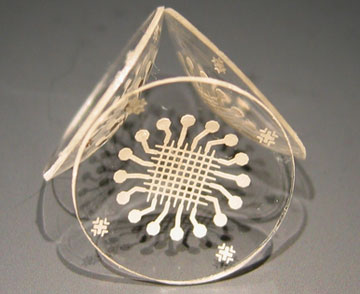Home > Press > Smart Contact Lenses
 |
| These contact lenses with a pattern of conductive silver wires could be used to measure pressure inside the eye and study glaucoma, a major cause of blindness. (Tingrui Pan/UC Davis photo) |
Abstract:
"Smart" contact lenses that measure pressure within the eye and dispense medication accordingly could be made possible using a new material developed by biomedical engineers at UC Davis.
Smart Contact Lenses
Davis, CA | Posted on August 7th, 2008Tingrui Pan, assistant professor of biomedical engineering, and postdoctoral researcher Hailin Cong started with a material called polydimethylsiloxane (PDMS). They developed a method for placing powdered silver on the PDMS in a precise pattern, to create conductive wires. The silver also has antimicrobial properties.
The researchers were able to shape the PDMS-silver into a contact-lens shape, and show that it could function as a simple pressure sensor. Glaucoma, a build-up of pressure in the eye, is a leading cause of blindness worldwide. A contact lens that could continuously measure pressure within the eye and relay the data to a computer would allow doctors to learn more about glaucoma and improve patient treatment.
The researchers plan to apply for approval to begin trials of the lenses in humans, Pan said. They are collaborating with Professor James Brandt of the Department of Ophthalmology at the UC Davis School of Medicine.
A paper describing the fabrication technique was published in the July 2008 issue of the journal Advanced Functional Materials.
####
For more information, please click here
Contacts:
Tingrui Pan
Biomedical Engineering
(530) 754 9508
Andy Fell
UC Davis News Service
(530) 752-4533
Copyright © UC Davis
If you have a comment, please Contact us.Issuers of news releases, not 7th Wave, Inc. or Nanotechnology Now, are solely responsible for the accuracy of the content.
| Related News Press |
News and information
![]() Researchers develop molecular qubits that communicate at telecom frequencies October 3rd, 2025
Researchers develop molecular qubits that communicate at telecom frequencies October 3rd, 2025
![]() Next-generation quantum communication October 3rd, 2025
Next-generation quantum communication October 3rd, 2025
![]() "Nanoreactor" cage uses visible light for catalytic and ultra-selective cross-cycloadditions October 3rd, 2025
"Nanoreactor" cage uses visible light for catalytic and ultra-selective cross-cycloadditions October 3rd, 2025
Nanomedicine
![]() New molecular technology targets tumors and simultaneously silences two ‘undruggable’ cancer genes August 8th, 2025
New molecular technology targets tumors and simultaneously silences two ‘undruggable’ cancer genes August 8th, 2025
![]() New imaging approach transforms study of bacterial biofilms August 8th, 2025
New imaging approach transforms study of bacterial biofilms August 8th, 2025
![]() Cambridge chemists discover simple way to build bigger molecules – one carbon at a time June 6th, 2025
Cambridge chemists discover simple way to build bigger molecules – one carbon at a time June 6th, 2025
![]() Electrifying results shed light on graphene foam as a potential material for lab grown cartilage June 6th, 2025
Electrifying results shed light on graphene foam as a potential material for lab grown cartilage June 6th, 2025
Discoveries
![]() Researchers develop molecular qubits that communicate at telecom frequencies October 3rd, 2025
Researchers develop molecular qubits that communicate at telecom frequencies October 3rd, 2025
![]() Next-generation quantum communication October 3rd, 2025
Next-generation quantum communication October 3rd, 2025
![]() "Nanoreactor" cage uses visible light for catalytic and ultra-selective cross-cycloadditions October 3rd, 2025
"Nanoreactor" cage uses visible light for catalytic and ultra-selective cross-cycloadditions October 3rd, 2025
Announcements
![]() Rice membrane extracts lithium from brines with greater speed, less waste October 3rd, 2025
Rice membrane extracts lithium from brines with greater speed, less waste October 3rd, 2025
![]() Researchers develop molecular qubits that communicate at telecom frequencies October 3rd, 2025
Researchers develop molecular qubits that communicate at telecom frequencies October 3rd, 2025
![]() Next-generation quantum communication October 3rd, 2025
Next-generation quantum communication October 3rd, 2025
![]() "Nanoreactor" cage uses visible light for catalytic and ultra-selective cross-cycloadditions October 3rd, 2025
"Nanoreactor" cage uses visible light for catalytic and ultra-selective cross-cycloadditions October 3rd, 2025
|
|
||
|
|
||
| The latest news from around the world, FREE | ||
|
|
||
|
|
||
| Premium Products | ||
|
|
||
|
Only the news you want to read!
Learn More |
||
|
|
||
|
Full-service, expert consulting
Learn More |
||
|
|
||








